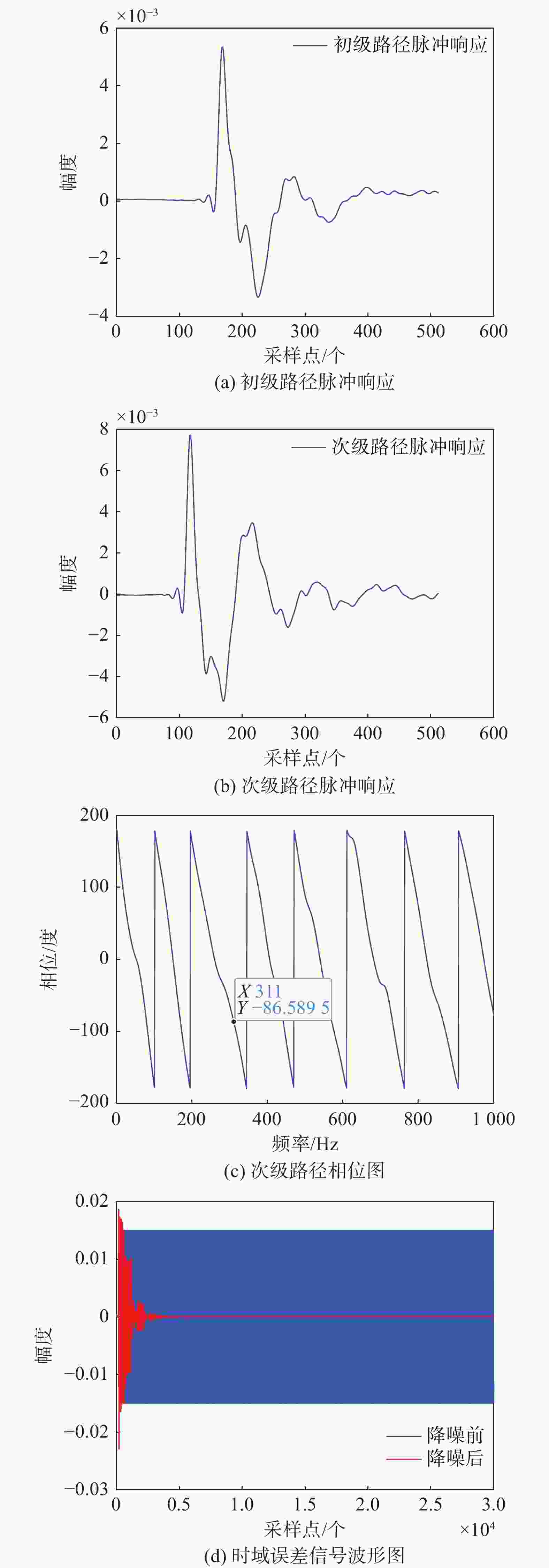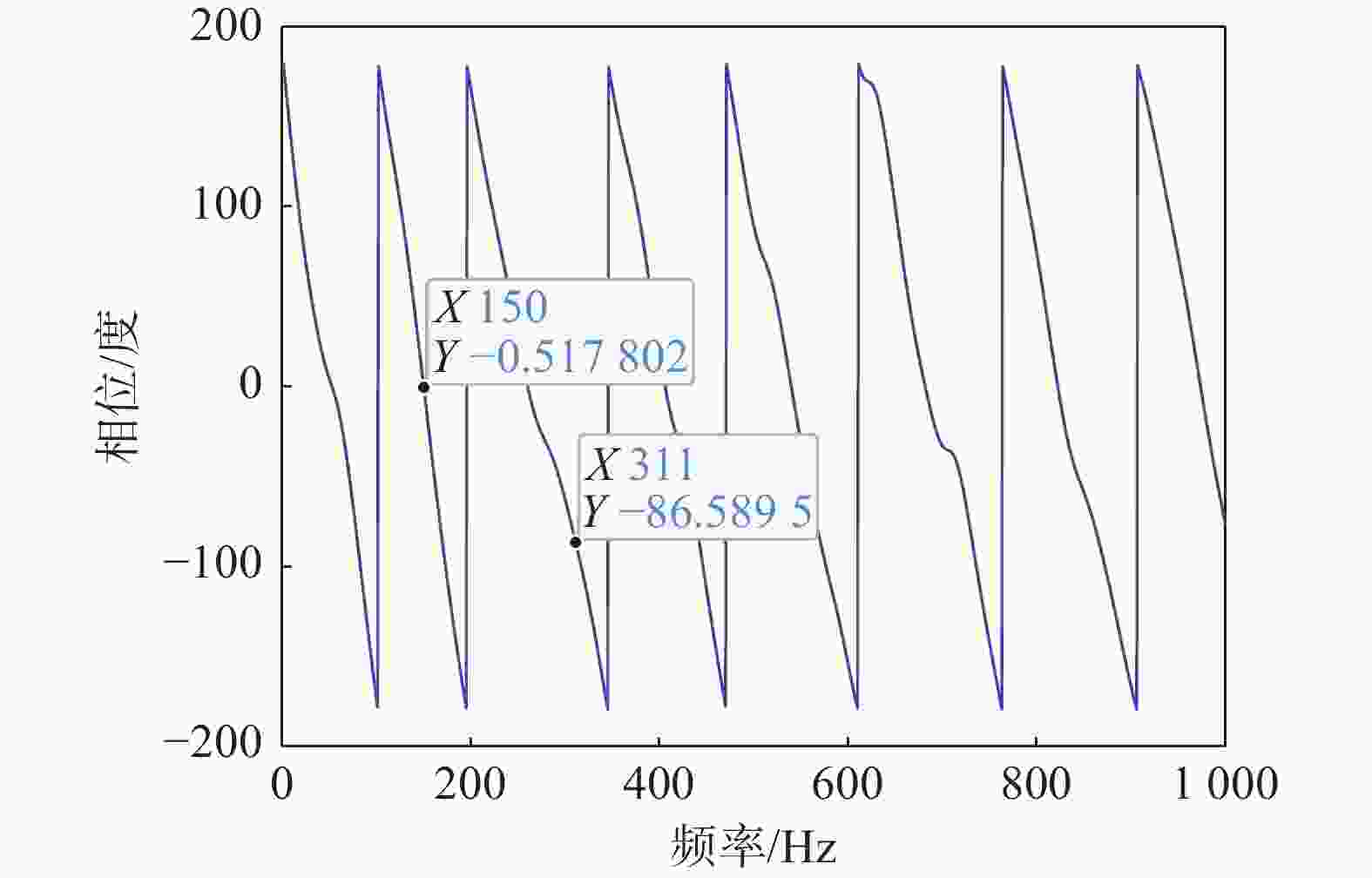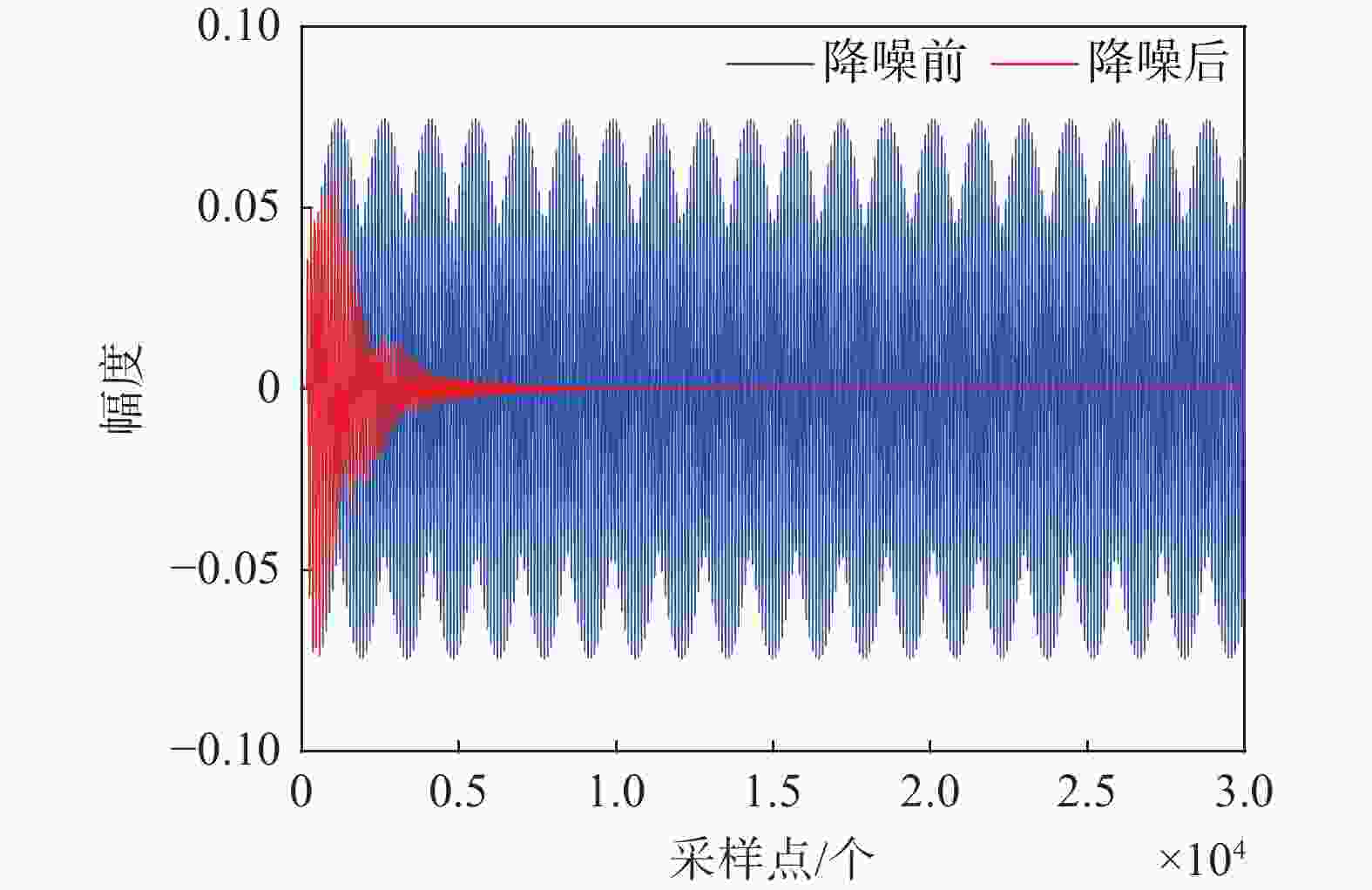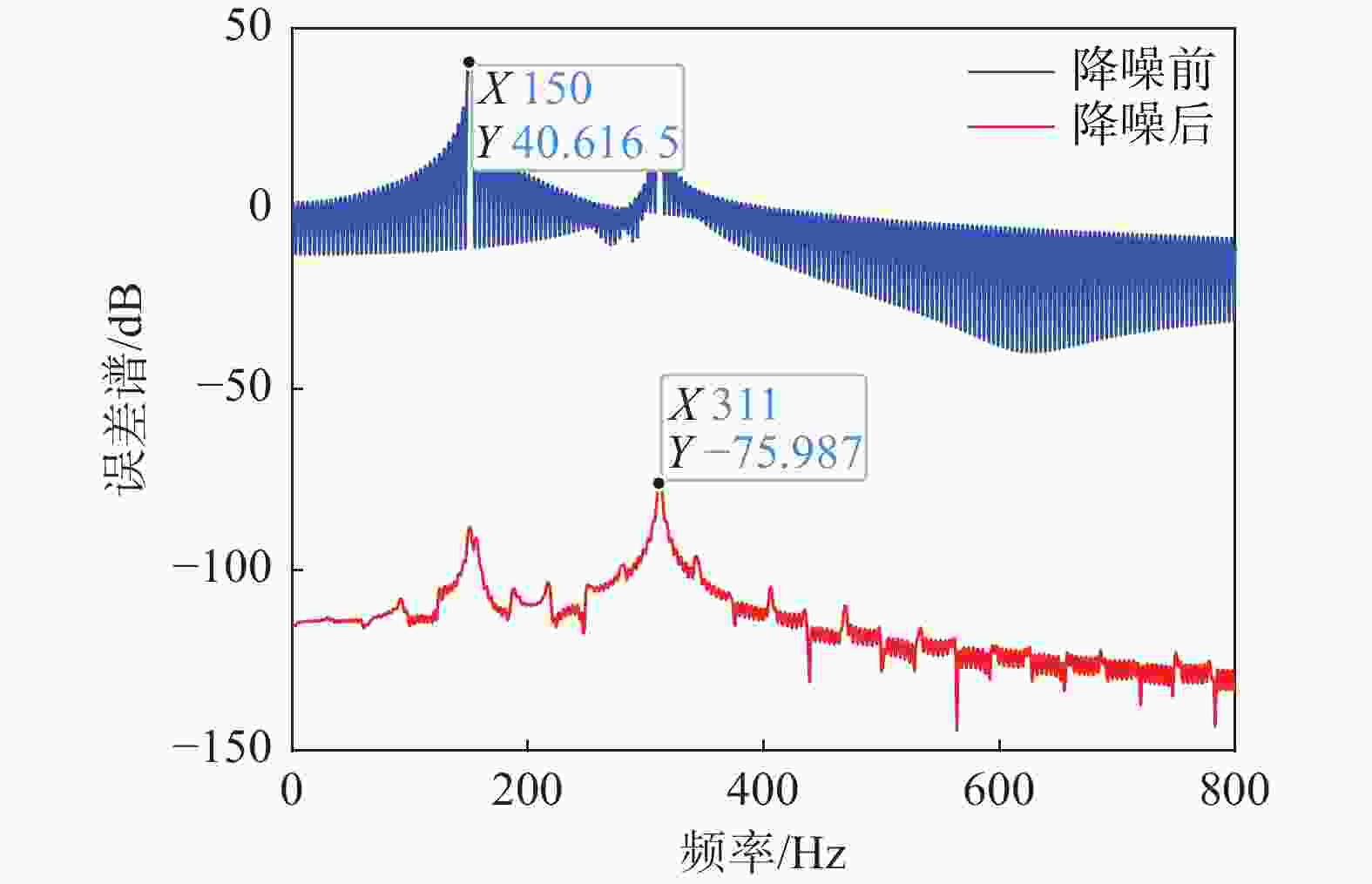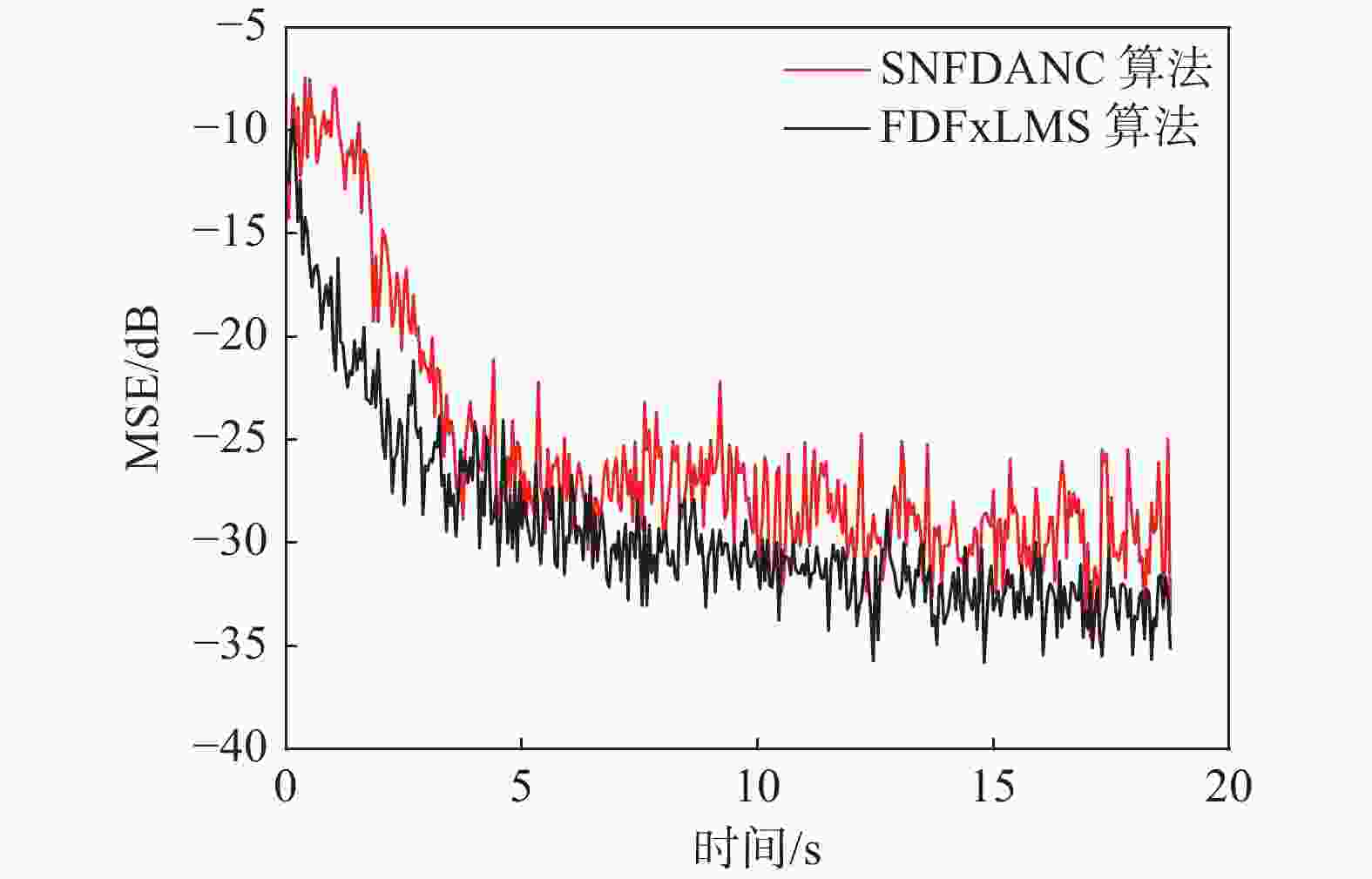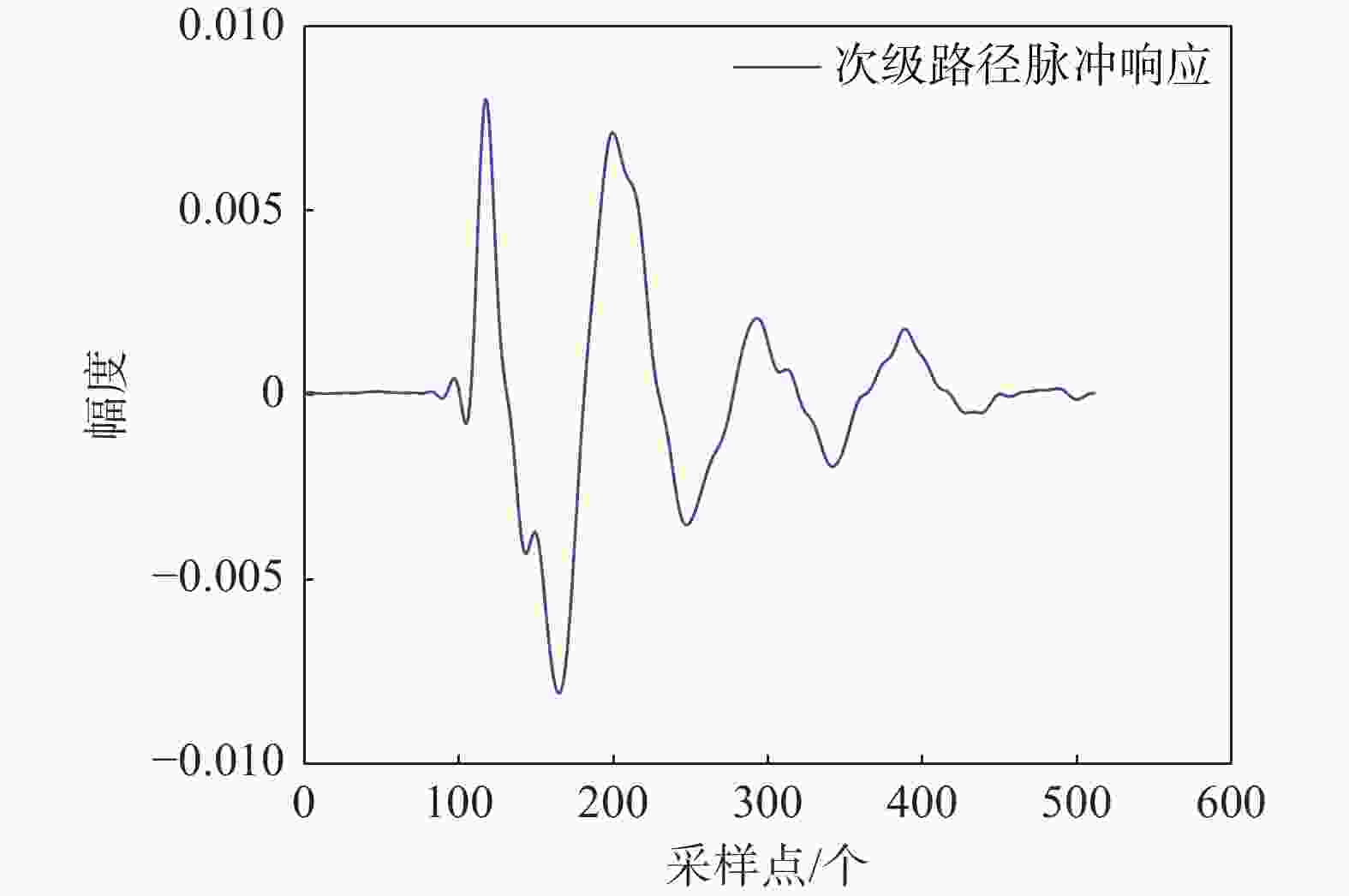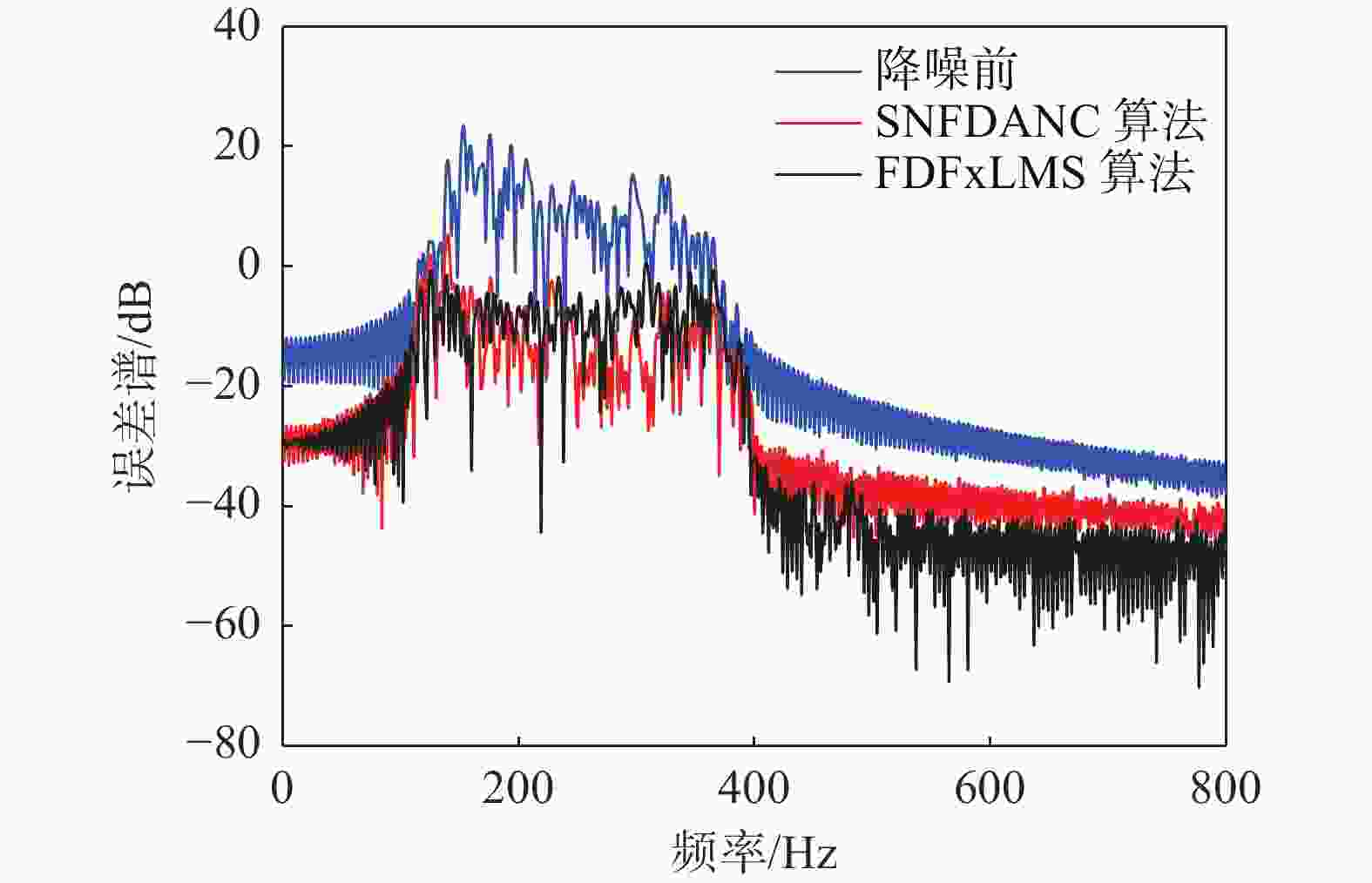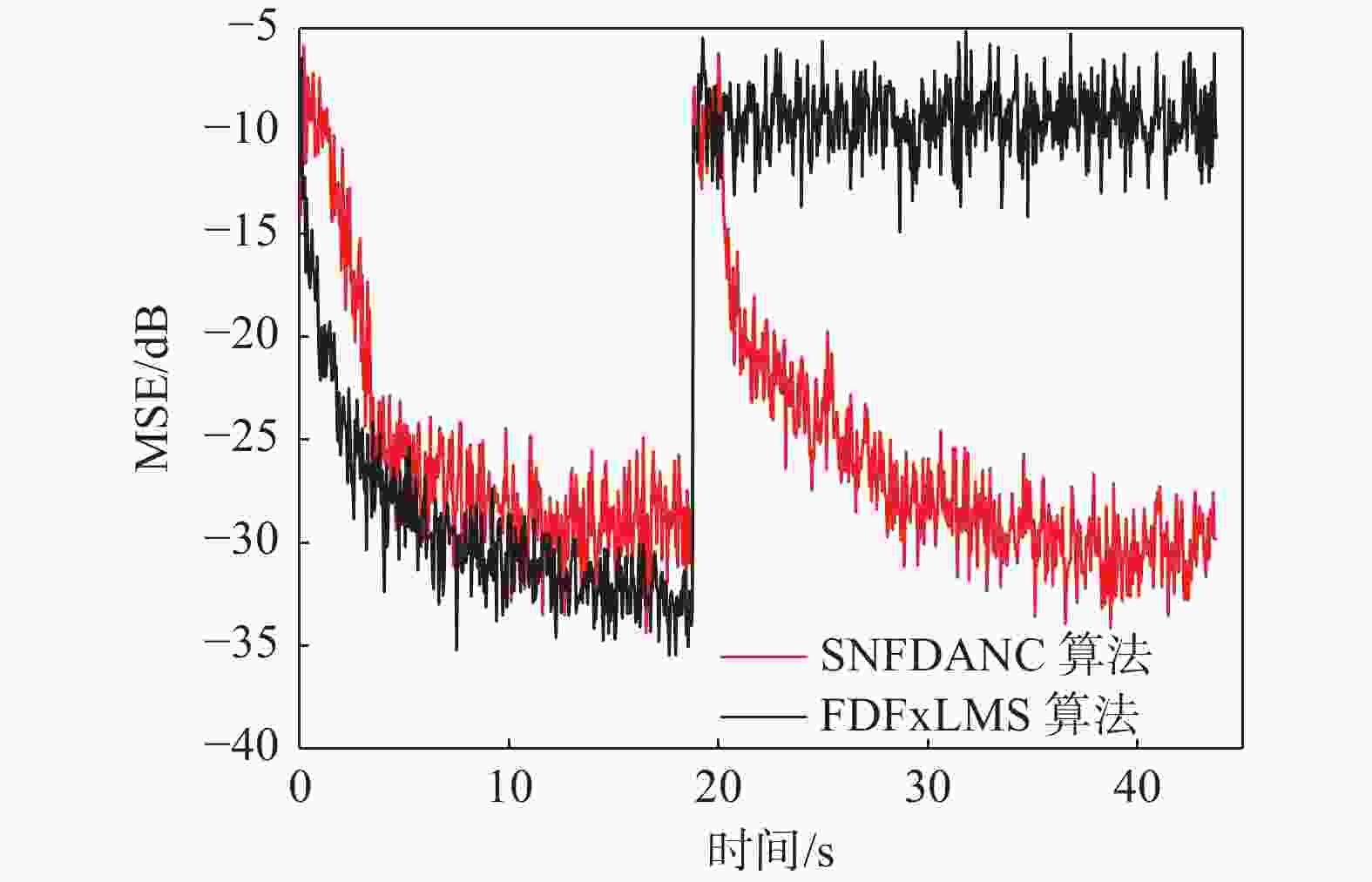A Simplified Narrowband Frequency-Domain Active Noise Control Algorithm without Secondary Path Modeling
-
摘要: 针对采样频率较高的窄带有源噪声控制系统,在无需次级路径信息基础上,提出简化窄带频域有源噪声控制算法,该算法将参考信号采样点代入离散傅里叶变换(DFT)定义式,直接计算与其频域参考信号、误差信号相对应频率柜的幅度和相位信息,并将这些频率柜均匀分为多个子频率柜组,然后每个子频率柜组在0°、180°以及±90°四个不同的方向,搜索判断并选择出该组内最佳方向,更新自适应滤波器系数,从而实现窄带降噪。与FDFxLMS算法比较,所提算法避免了全频带频率柜信息全部参与计算,提高计算效率,当有效频率柜个数满足一定条件时,可减少计算量。分别以单频、复合频率和窄带信号为初级噪声源进行仿真,仿真结果表明在降噪量不减的情况下,所提算法具有良好的稳定特性和跟踪特性。Abstract: For narrowband active noise control (ANC) systems with high sampling frequencies, a simplified narrowband frequency-domain ANC algorithm is proposed that does not require secondary path information. This algorithm directly calculates the amplitude and phase information of the frequency bins corresponding to the reference signal and error signal in the frequency domain by substituting the reference signal sampling points into the discrete Fourier transform (DFT) definition. These frequency bins are evenly divided into multiple sub-frequency bin groups. For each sub-frequency bin group, the optimal update direction for the adaptive filter coefficients is chosen from the four directions of 0°, 180°, and ±90° to achieve narrowband noise reduction. Compared to the FDFxLMS algorithm, the proposed algorithm avoids the participation of all full-band frequency bins in the calculation, thereby improving computational efficiency. When the number of effective frequency bins meets certain conditions, the computational complexity can be reduced. Simulations using single frequency, multi-frequency, and narrowband noise as primary noise sources demonstrate that the proposed algorithm maintains good noise reduction performance while exhibiting excellent stability and tracking characteristics.
-
Key words:
- metrology /
- active noise control /
- narrowband /
- discrete Fourier transform /
- frequency bin /
- phase response
-
表 1 SNFDANC算法方向搜索
Table 1. The direction search of SNFDANC algorithm
SNFDANC算法方向搜索 搜索频率柜组更新方向过程: 1.分别计算参考信号、误差信号连续P个采样点的能量$ {\chi _0} = \displaystyle\sum\limits_{i = 0}^{P - 1} {{x^2}(k)} $ 和$ {\xi _0} = \displaystyle\sum\limits_{i = 0}^{P - 1} {{e^2}(k)} $。
重复2至4的步骤,对各子频率柜组选择最佳更新方向。以选择第m个子频率柜更新方向举例说明。2. 在自适应滤波器的系数未更新时,先计算第m个频率柜组噪声能量$ {\chi _1} = \displaystyle\sum\limits_{k = 0}^{P - 1} {{{\left| {{x_m}(k)} \right|}^2}} $,误差信号能量$ {\xi _1} = \displaystyle\sum\limits_{k = 0}^{P - 1} {{{\left| {{e_m}(k)} \right|}^2}} $,找出误差最大值$ {e_{\max }} = \max [\left| {{e_m}(k)} \right|] $。 3. 在0°、180°和±90°四个更新方向中判断并选择该频率柜组自适应滤波器系数更新方向。
a.分别在四个不同更新方向下,对同一个频率柜组,计算参考信号能量χ2和误差信号能量ξ2,并判断,当满足条件|em(k)| >(1+δ)emax时,停
止自适应滤波器系数更新。
b. 当满足|em(k)| <(1+δ)emax时,更新式(8)。4. 比较步骤3中,在四个不同更新方向下所计算的误差信号能量ξ2,选取四个ξ2值中最小值所对应的更新方向,即为该频率柜组最优方向。 自适应滤波器系数更新过程: 5. 根据搜索方向过程确定出相应的每个频率柜组最优更新方向,并和各子频率柜组参考信号和误差信号一起使用式(8)迭代更新。 当声场环境发生变化: 6. 当k 取 1时,直接赋值χ(0) =χ0,ξ (0) = ξ0。 7. 迭代计算信号能量$ \chi (k) = \lambda \chi (k - 1) + {\left| {x(k)} \right|^2} $和$ \xi (k) = \lambda \xi (k - 1) + {\left| {e(k)} \right|^2} $,λ为小于1的可调参数。 8. 如果 ξ0/χ0<ξ(k)/χ(k),返回搜索更新方向步骤,否则继续迭代自适应滤波器系数。 表 2 两个频率步长和相位
Table 2. The step size and phase of two frequencies
频率/Hz 步长 最佳更新方向 实际相位/度 150 0.001*1 0° −0.517802 311 0.001*j −90° −86.5895 表 3 各频率柜步长和相位
Table 3. The step size and phase of frequency bins
频率柜组 步长 最佳更新方向 [10 12] 0.003*1 0° [13 15] 0.003*(−1) 180° [16 18] 0.003*1 0° [19 21] 0.003*j −90° [22 24] 0.003*(−1) 180° 表 4 开口声场各频率柜步长和相位
Table 4. The step size and phase of open acoustics
频率柜组 步长 最佳更新方向 [10 12] 0.003*1 0° [13 15] 0.003*(−1) 180° [16 18] 0.003*1 0° [19 21] 0.003*(−1) 180° [22 24] 0.003*(j) 90° 表 5 两种算法计算量
Table 5. The computational complexity of the two algorithms
步骤 FDFxLMS算法 SNFDANC算法 离线建模获取次级路径信息 N 0 计算频域滤波参考信号 2N×4+2N×log2(2N) 0 频域参考信号和误差信号 4N×log2(2N) 0 计算参考信号频率柜信息 0 2JN 计算误差信号频率柜信息 0 2JN 自适应滤波器系数更新过程 2Nlog2(2N)+2N×4 8JN 总计 17N+8Nlog2(2N) 12JN 表 6 不同自适应滤波器长度计算量比较
Table 6. The computational complexity comparison of different adaptive filter lengths
自适应滤波器长度N FDFxLMS算法 SNFDANC算法 SNFDANC算法最大频率柜个数 256 22784 21504 7 512 49664 49152 8 1024 107520 98304 8 2048 231424 221184 9 4096 495616 491520 10 8192 1056768 983040 10 -
[1] 陈克安. 有源噪声控制[M]. 北京: 国防工业出版社, 2014: 4–12. [2] 刘策, 陈剑, 李家柱. 基于声阵列技术的车辆通过噪声室内测量方法[J]. 计量学报, 2019, 40(6): 1096-1100. doi: 10.3969/j.issn.1000-1158.2019.06.25 [3] 秦朝琪, 黄杰, 白滢, 等. 机动车行进中鸣笛声监测的校准方法研究[J]. 计量科学与技术, 2021, 65(8): 42-45. doi: 10.12338/j.issn.2096-9015.2020.9033 [4] 毛宏宇, 杨平, 何龙标, 等. 国内外飞机噪声标准研究进展及对比分析[J]. 计量科学与技术, 2022, 66(1): 9-13. [5] 代元军, 姜金榜, 吴柯, 等. 水平轴风力机叶片气动噪声源分布特性的试验研究[J]. 中国测试, 2023, 49(1): 31-35. [6] C H Hansen, S D Snyder. Active Control of Sound and Vibration[M]. London: E&FN Spon, 1997. [7] S M Kuo, D R Morgan. Active Noise Control Systems: Algorithm and DSP Implementations[M]. New York: Wiley, 1996. [8] S J Elliott. Signal Processing for Active Control[M]. London: Academic, 2001. [9] 褚轶景, 赵越喆, 牛锋, 等. 基于状态方程的Fx-RLS主动噪声控制方法[J]. 计量学报, 2023, 44(11): 1713-1718. doi: 10.3969/j.issn.1000-1158.2023.11.12 [10] Zhang J , Elliott S J , Cheer J . Robust performance of virtual sensing methods for active noise control[J]. Mechanical Systems and Signal Processing, 2021, 152(9): 107453. [11] Shen Q , Spanias A S . Time and frequency domain X-block LMS algorithms for active noise control[J]. Noise Control Engineering Journal, 1996, 1: 353-360. [12] 熊德智, 肖宇, 胡军华, 等. 矩形窗三点插值傅里叶变换高精度频率估计方法[J]. 中国测试, 2023, 49(9): 57-62. doi: 10.11857/j.issn.1674-5124.2021120030 [13] Elliott S J , Rafaely B . Frequency-domain adaptation of causal digital filters[J]. IEEE Transactions on Signal Processing, 2000, 48(5): 1354-1364. [14] 马进, 邹海山, 邱小军. 存在声反馈的前馈有源噪声控制系统性能分析[J]. 声学学报, 2016, 41(5): 686-693. doi: 10.15949/j.cnki.0371-0025.2016.05.018 [15] Hu M , Xue J , Lu J . Online multi-channel secondary path modeling in active noise control without auxiliary noise[J]. The Journal of the Acoustical Society of America, 2019, 146(4): 2590–2595. [16] Chen W , Lu C , Liu Z , et al. A computationally efficient active sound quality control algorithm using local secondary-path estimation for vehicle interior noise[J]. Mechanical Systems and Signal Processing, 2022, 168: 108698. [17] Yang T , Zhu L , Li X , et al. An online secondary path modeling method with regularized step size and self-tuning power scheduling[J]. Journal of the Acoustical Society of America, 2018, 143(2): 1076-1084. [18] Chu YJ, Chan SC, Mak CM, et al. A Diffusion FxLMS algorithm for multi-channel active noise control and variable spatial smoothing[C]. Toronto : IEEE International Conference on Acoustics, 2021. [19] Gong C , Wu M , Guo J , et al. Multichannel narrowband active noise control system with a frequency estimator based on DFT coefficients[J]. Journal of Sound and Vibration, 2022, 521: 116660. [20] Gong C , Wu M , Guo J , et al. Modified narrowband active noise control system with frequency mismatch tolerance[J]. Applied Acoustics, 2022, 189: 108598. [21] Zhou D , Debrunner V . A New Active Noise Control Algorithm That Requires No Secondary Path Identification Based on the SPR Property[J]. IEEE Transactions on Signal Processing, 2007, 55(5): 1719-1729. [22] Wu M , Chen G , Qiu X . An Improved Active Noise Control Algorithm Without Secondary Path Identification Based on the Frequency-Domain Subband Architecture[J]. IEEE Press, 2008, 16(8): 1409-1419. [23] D R Morgan, J C Thi. A delayless subband adaptive filter architecture[J]. IEEE Trans. Signal Processing, 1995, 43(8): 1819-1830. doi: 10.1109/78.403341 [24] J Huo, S Nordholm, Z Zang. New weight transform schemes for delayless adaptive filtering[C]. Proceedings of IEEE Global Telecommunications Conference, 2001. [25] Milani A A , Panahi I M S , Briggs R . Distortion analysis of subband adaptive filtering methods for FMRI active noise control systems. [C]. International Conference of the IEEE Engineering in Medicine & Biology Society, 2007. [26] Larson L O , Haan J M D , Claesson I . A new subband weight transform for delayless subband adaptive filtering structures[C]. International Conference on Digital Signal Processing, 2002. [27] Min Gao, Jing Lu, Xiaojun Qiu. A Simplified Subband ANC Algorithm Without Secondary Path modeling[J]. IEEE/ACM transactions on audio, speech, and language processing, 2016, 24(7): 1164-1174. doi: 10.1109/TASLP.2016.2516439 [28] K Chen, J Xue, J Lu, et al. Improving active noise control without secondary path modeling using subband phase estimation[J]. J. Acoust. Soc. Am, 2020, 147(2): 1275-1283. doi: 10.1121/10.0000743 [29] Chen K , Niu F , Zou H , et al. Modification of frequency-domain active noise control algorithm without secondary path modeling[J]. The Journal of the Acoustical Society of America, 2021, 149(2): 1021-1029. [30] Simon O Haykin. Adaptive Filter Theory [M]. Fifth Edition . London: Prentice Hall, 2017. -


 作者投稿
作者投稿 专家审稿
专家审稿 编辑办公
编辑办公

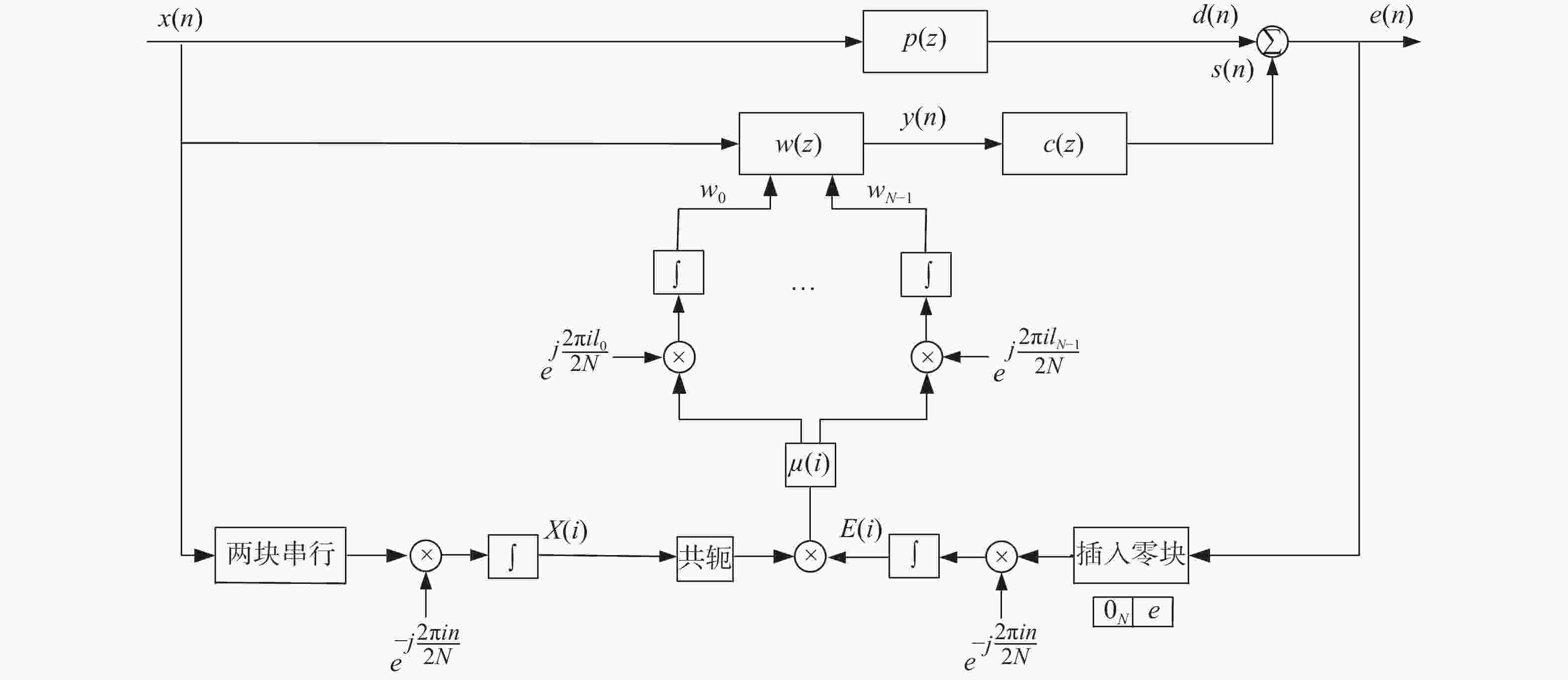
 下载:
下载:
